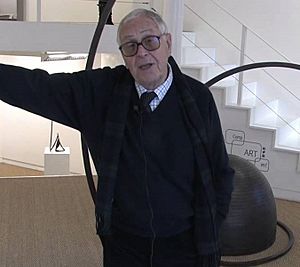Martín Chirino facts for kids
Quick facts for kids
Martín Chirino
|
|
|---|---|

Martín Chirino at an exhibition
|
|
| Born |
Martín Chirino López
1 March 1925 Las Palmas de Gran Canaria, Spain
|
| Died | 11 March 2019 (aged 94) Madrid, Spain
|
| Awards | National Award for Plastic Arts (1980) |
Martín Chirino López (born March 1, 1925 – died March 11, 2019) was a famous Spanish sculptor. He was one of the people who started the art group called El Paso (which means "The Step") in 1957. Martín Chirino mostly created his art using iron. His sculptures are known as abstract art, which means they don't show real-life things exactly as they look.
Contents
About Martín Chirino
Early Life and Art Studies
Martín Chirino was born on March 1, 1925, in Las Palmas de Gran Canaria, Spain. This city is located in the beautiful Canary Islands.
He moved to Madrid in 1948 to study art. He attended the Royal Academy of Fine Arts of San Fernando. In 1952, he finished his studies and became a professor of Fine Arts.
The next year, he traveled to London to continue learning. He took classes at the Royal Academy of Arts. This helped him become an even better sculptor. After his time in London, he went back to Las Palmas. There, he worked closely with his friend, the artist Manolo Millares.
Founding the El Paso Art Group
After showing his art in the Canary Islands, Chirino moved to Madrid in 1955. He went with his friends Manolo Millares, Elvireta Escobio, Manuel Padorno, and Alejandro Reino.
He had his first solo art show at the Ateneo de Madrid. In February 1957, a new art group was formed. It was called El Paso, which means "The Step." Martín Chirino joined this important group. Other artists in El Paso included Antonio Saura and Manolo Millares.
The El Paso group broke up in May 1960. This happened because the artists had different ideas. After the group ended, Chirino opened his own art studio. It was in San Sebastián de los Reyes.
Creating Unique Sculptures
In 1964, Martín Chirino took a two-month trip to Greece. This trip gave him ideas for a new series of sculptures. He called this collection "Mediterránea."
In 1966, a new museum opened in Cuenca, Spain called the Museo de Arte Abstracto Español. This museum bought two of his artworks for its collection. These were "Raíz" (meaning "Root") from 1958 and "El Viento" (meaning "The Wind") from 1966.
In 1969, Chirino had a special art show in New York City. It was at the Grace Borgenicht Gallery. He showed his "Mediterráneas" sculptures there. These sculptures were made from iron sheets. They were painted in bright, lively colors. Around this time, Chirino started making hollow shapes in his art.
He won his first international award in Italy. It was at the X Concorso Internazionale del Bronzetto de Padova. Later, he showed a new collection at the Grace Borgenicht Gallery. These were called "Aeróvoros." These sculptures looked like they were floating or flying. The famous Guggenheim Museum bought one of these amazing sculptures.
In 1978, he won first prize at an international sculpture event in Budapest. The next year, his "Afrocan" exhibition got great reviews from newspapers in New York.
Awards and Public Art
Martín Chirino received many important awards for his art. In 1980, he won the Spanish National Award for Plastic Arts. Five years later, he was given the Gold Medal of Merit in the Fine Arts.
In 1989, Chirino became the director of a new art museum. It was the Centro Atlántico de Arte Moderno (CAAM) in Las Palmas. He was also the director of the Círculo de Bellas Artes in Madrid since 1982.
Many of Chirino's sculptures became important symbols. In 1996, his sculpture "Lady Harimaguada" was put in place. It became a symbol of Las Palmas. Its design is even used for the trophy at the Festival Internacional de Cine de Las Palmas de Gran Canaria.
In 1999, his "Spiral" sculpture was installed at the Canarian Parliament Building. This building now uses the "Spiral" as its symbol. The Universidad de Las Palmas de Gran Canaria also uses an image of his sculpture "El Pensador" (meaning "The Thinker") in its logo.
In 2002, Chirino stepped down as director of the CAAM museum. On October 11, 2014, he was made an honorary member of the Real Academia de Bellas Artes de San Fernando.
Martín Chirino passed away in Madrid on March 11, 2019. He was 94 years old. His art continues to inspire many people around the world.
See also
 In Spanish: Martín Chirino para niños
In Spanish: Martín Chirino para niños




